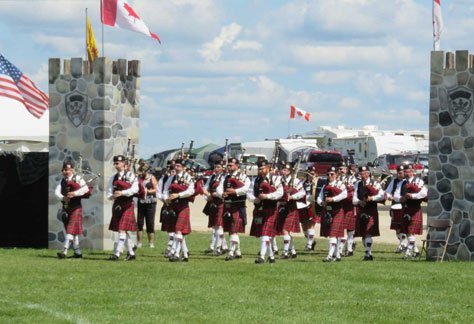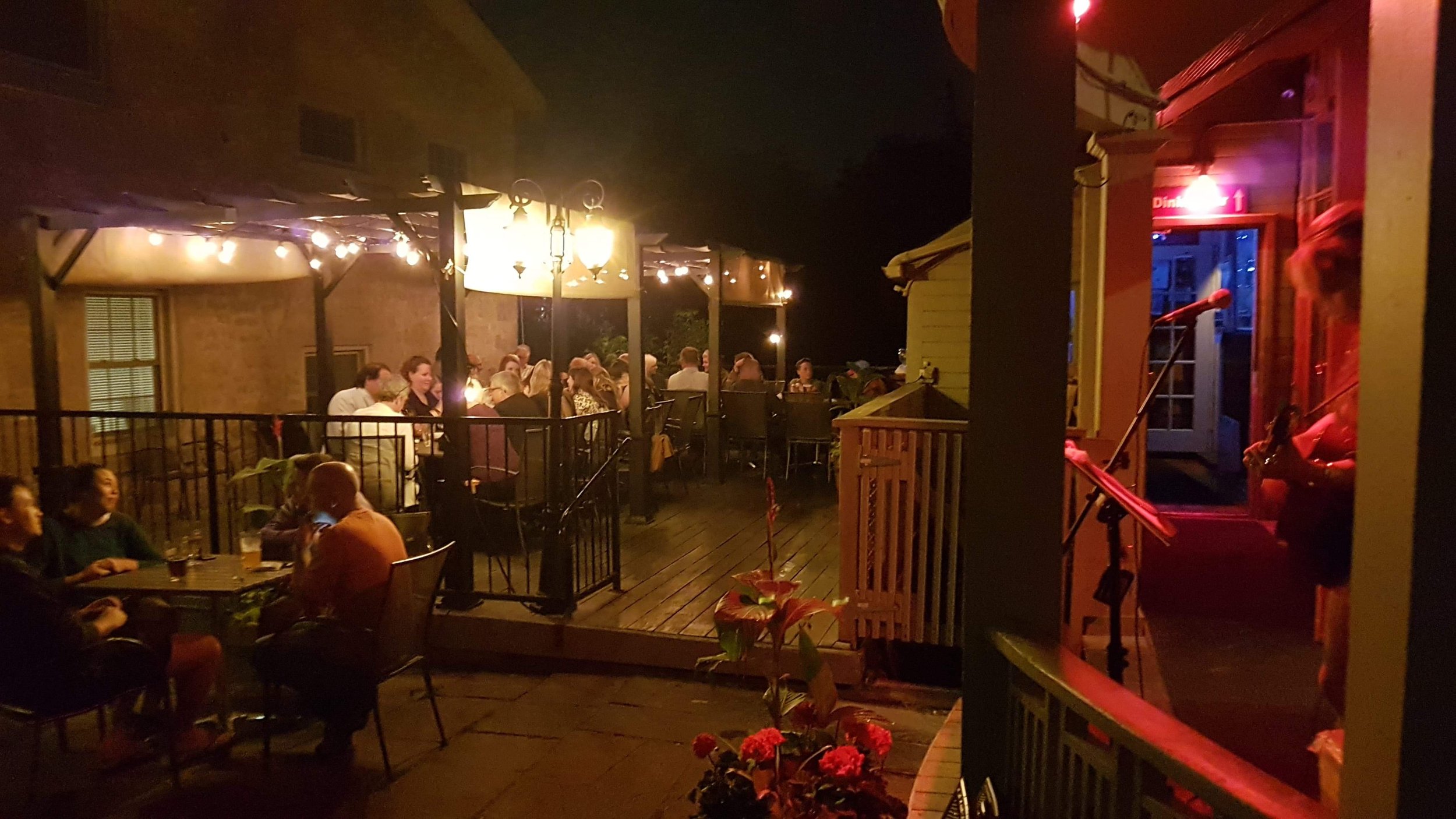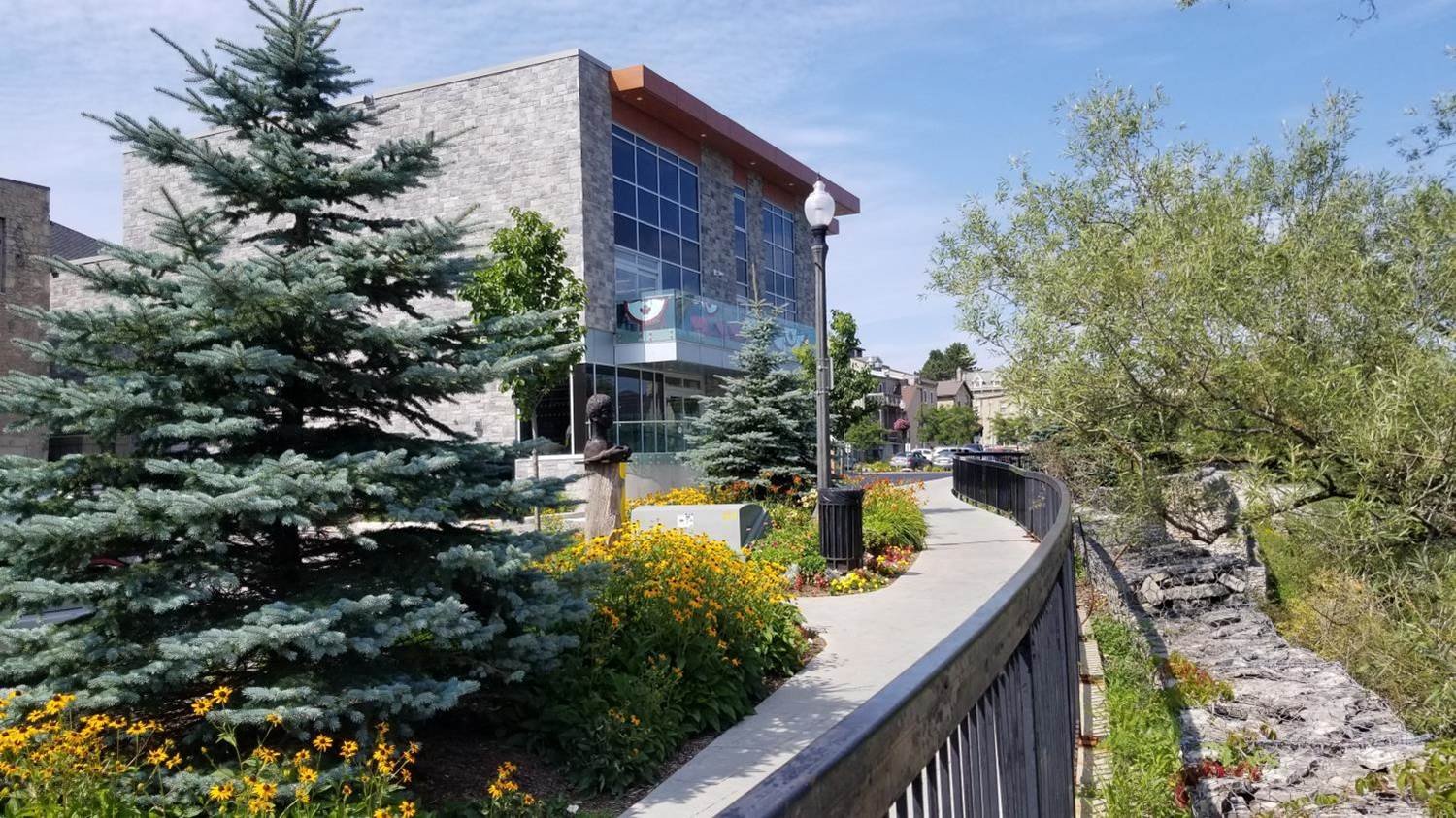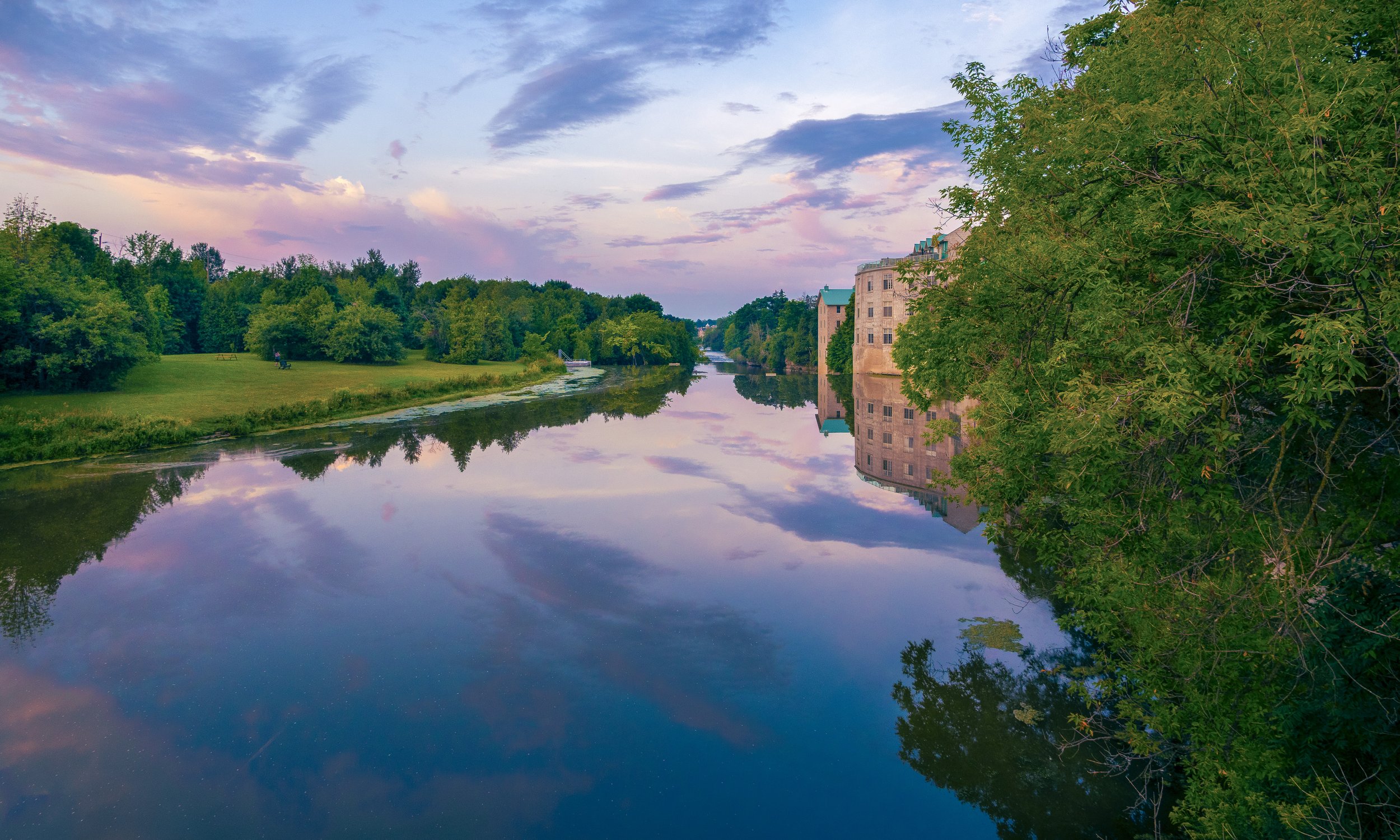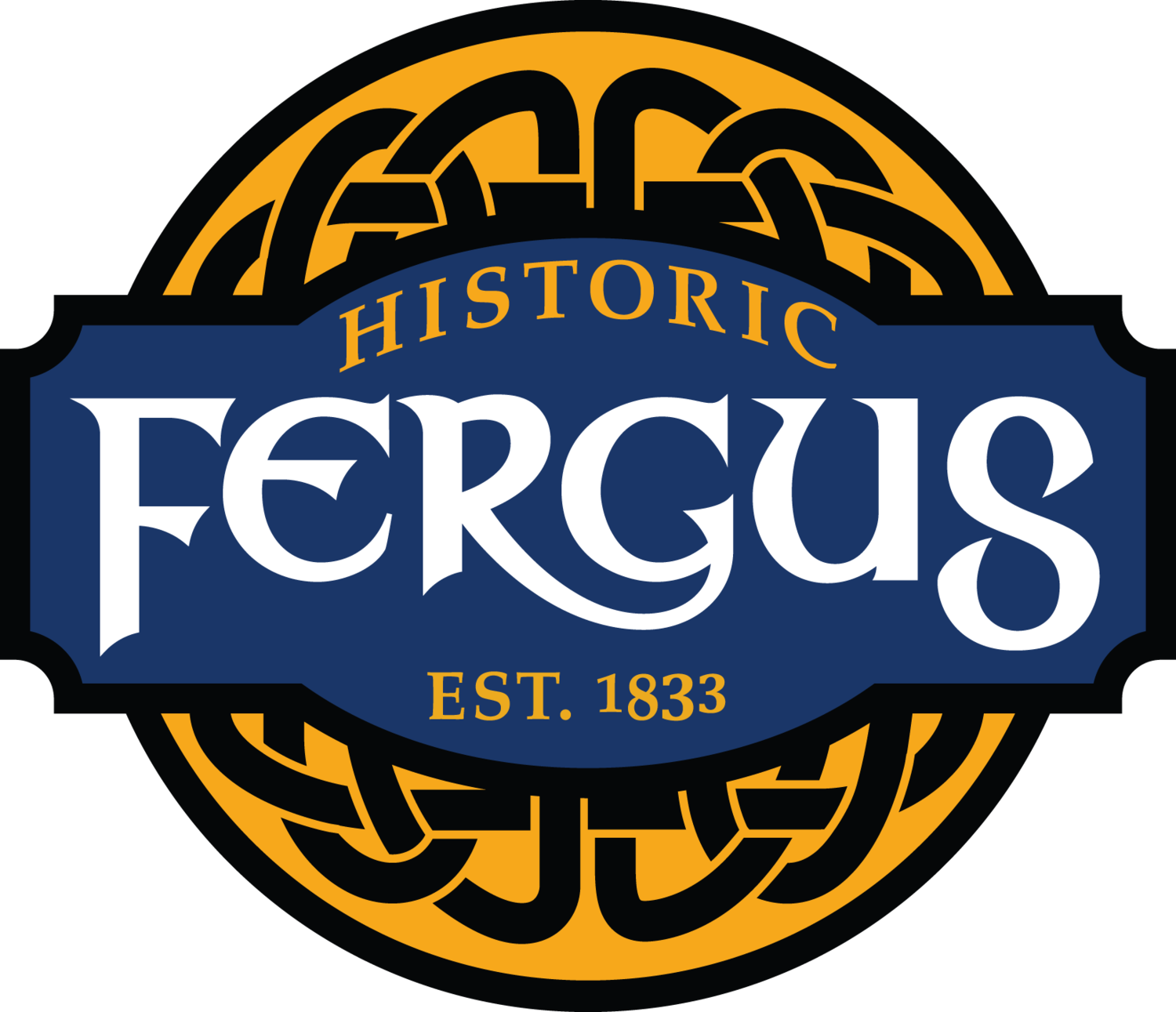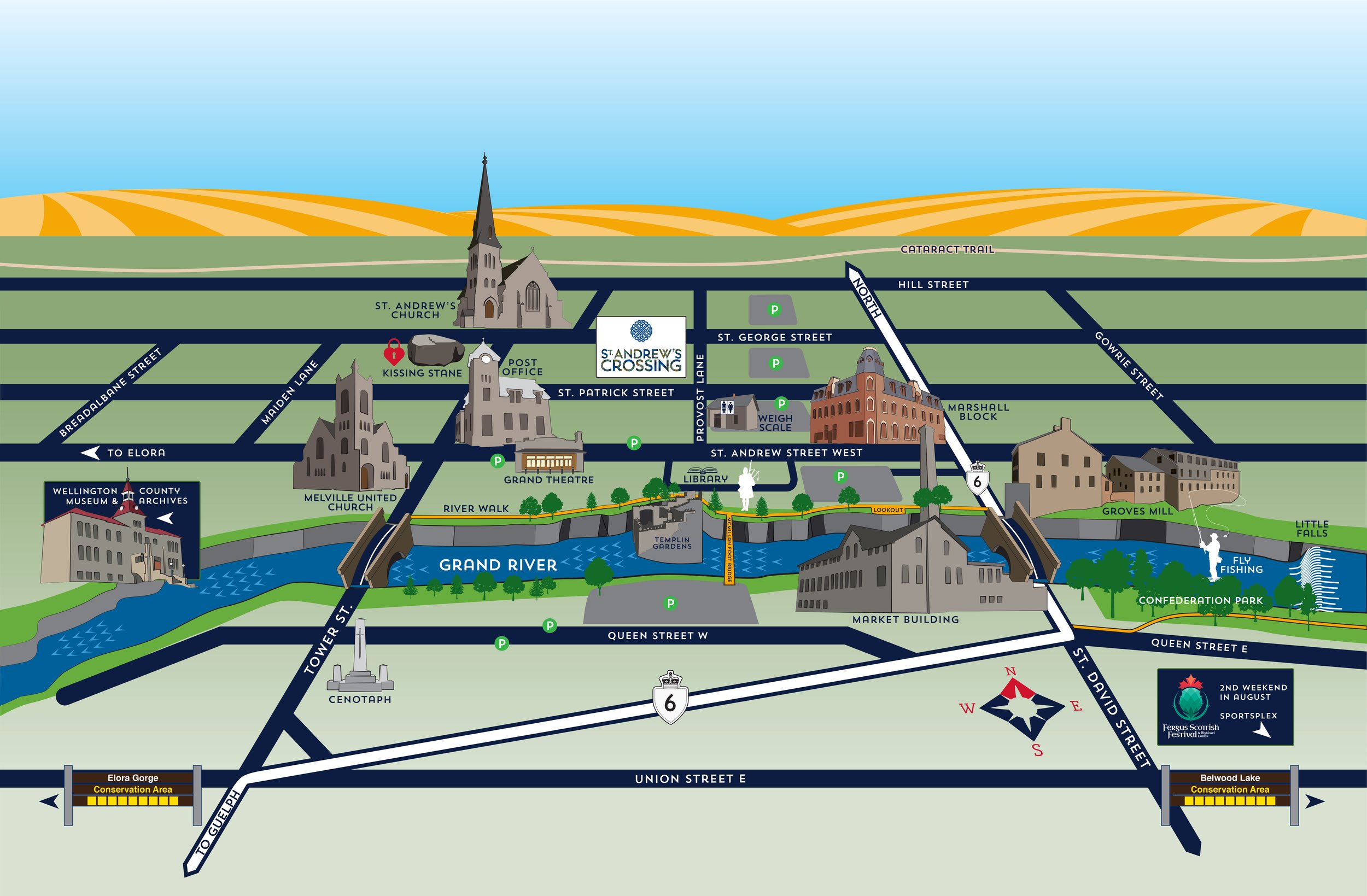

Built on the Grand River, Fergus boasts historic buildings, natural beauty, and community pride.

Living Local
Visiting Fergus and looking for stuff to do?
We have many events that take place during the year from our spectacular Scottish Festival on the second weekend of August to our Fall Fair and our new Medieval Faire. Check our Events page for these yearly events.
If you happen to find yourself in our area and are looking for something to do, we have lots of options!
Pubs
Trivia Night at The BrewHouse on the Grand is Monday nights!
Wing night at The BrewHouse on the Grand is Tuesday nights.
Wing night at The Breadalbane Inn/ Scozia Restaurant is Wednesday nights.
Wing night at The Goofy Newfie is Thursday and have half price Mussels on Tuesday nights!
Live Music
Wednesday nights in July and August hosts Twilight at Templin in Templin Gardens, a free music event from 7-9 pm with a Handmade Market that starts at 5pm. Many of our Pubs have live music as well!
Theatre
The Fergus Grand Theatre offers various shows throughout the year – see their schedule here.
Trails
Did you also know that Centre Wellington has a Rail to Trails that you can bike, hike or walk? If you find yourself without a bike, pop into The Bicycle Tailor (downtown Fergus) to rent one!
Fishing
Visit The Troutfitters for guided fishing trips, fly-tying classes or for the lowdown on our world class fishing holes!
Yoga
The Forge hosts a drop in Yoga class Sunday Mornings at 10 am – check before arriving.
Swimming
The Elora Quarry is always a favourite and nice and close. The Belwood GRCA also has a little gem of a swim hole, perfect for families! Pack a picnic! Or bring a boat and use the launch to spend some time on the Lake. The Fergus Community Sportsplex has a great pool with open swim times during the week.
Workshops
Joanie’s for stained glass workshops.
String Theory has a variety of workshops.
Echoes on Templin also offers workshops.
Public Library
Our Downtown Public Library is open 7 days a week and until 8 on weeknights.
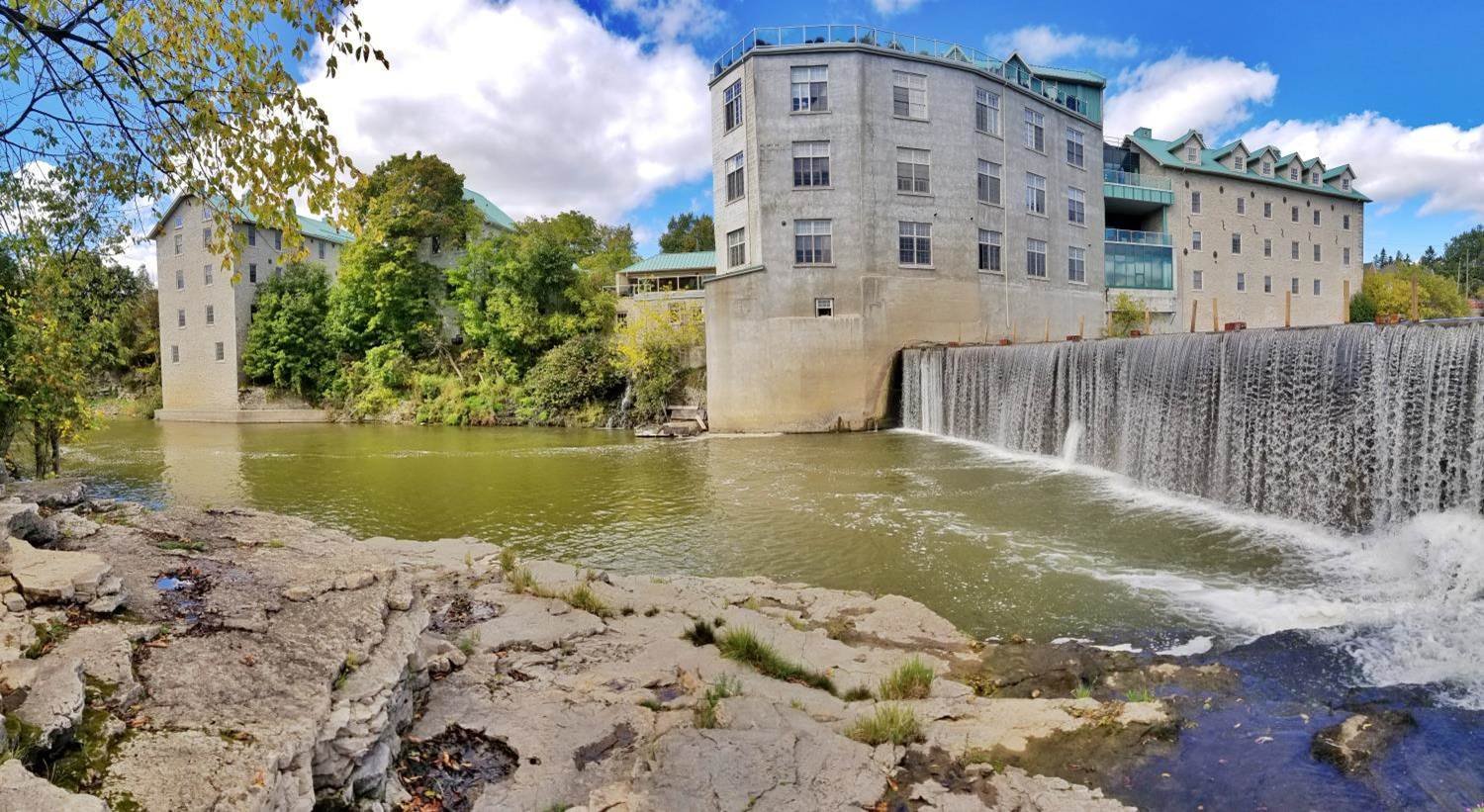
Self-guided Walking Tour
#1 Historic Post Office
Your tour begins at The Post Office building, which you see today on the north side of St. Andrew St. It was built in 1911 on the site of the original Post Office, built in 1835 by Thomas Young. Mr. Young had a frame, one story building which he used as a store and post office. This corner was the core of the settlement in the 1830’s. The area where the Canada Trust is now located was considered “the common” or “market square” as it was the only level and cleared patch of ground on the north side of the river.
#2 Melville United Church
Cross Tower St. and proceed west and you will find Melville United Church on the south side of St. Andrew St. and Tower St. This church was built in 1900 to replace the old Melville Church which was located on the south side of the river on the trail to Elora.
#3 Breadalbane Inn
Continue west along St. Andrew St. to Breadalbane St. On the north corner stands the Breadalbane Inn, the former home of George D. Fergusson, son of Adam Fergusson, co-founder of Fergus. George came to Fergus in 1851 to oversee his father’s business interests. A very small stone cottage at the back of the property was eventually engulfed by the present day structure in the 1870’s expanded to accommodate George’s large family of 10 children. The building was converted to the existing inn and restaurant business in the 1970’s.
#4 St. Joseph's Catholic Church
Continue north on Breadalbane St. and turn east on St. Patrick St. St. Joseph’s Catholic Church is located on the corner of Maiden Lane and St. Patrick St. This church started as a small frame structure and was replaced with the present day stone building in 1865. This church originally had a tall top heavy steeple, which was blown over and embedded into St. Patrick St. during a vicious storm in November 1913. Mario Landoni Sr. repaired the damage and reshaped the steeple. In the early 1900’s, after George Fergusson died, the village fathers gave permission for the hill west of the church to be used as a gravel pit, and later a village dump. This abruptly ceased when it became apparent that this was indeed the catholic burial ground.
#5 St. Andrew's Presbyterian Church
Continue north on Maiden Lane to St. George St. and turn east. St. Andrew’s Presbyterian Church (on the hill) was established in December 1834. The first church, a wooden structure, was replaced in 1861 by the present stone building. Behind the church, you will find the first burial ground for the village. The Auld Kirk Yard contains the remains of most of the earliest settlers. Some of the most interesting headstones have been moved into the west vestibule of the church for safekeeping. Part of the Auld Kirk Yard was set aside as the pauper’s cemetery during the Highlander’s trek of 1849-1855.
#6 Stone Cottage of Samuel Small, Shoemaker
The small stone cottage to your right on the west corner of St. Patrick and Provost Lane was built for Samuel Small, Shoemaker. This one and one quarter story design is typical of the small tenant housing in some parts of Scotland. If there were no windows on the second floor, the building was taxed as a one story dwelling, even though there were rooms, or a loft above the main area. These small dwellings were inexpensive to build and easy to heat and maintain.
#7 Weigh Scale Building
Continue further down Provost Lane. Just before St. Andrew St. you will come across the Weigh Scale Building (on the east side). This is one of the last remaining weigh scale buildings in Ontario. Now housing the public washroom facilities, the building is home to some interesting historical images of the area.
#8 First Dwelling in the Settlement of 'Little Falls'
Retrace your steps north on Provost St. and turn east on St. Patrick St. to the municipal parking lot. Here, behind John Thomson & Son Furniture (and a little to the east), Mr. Scott built the first dwelling the settlement of “Little Falls”. James Webster and William Built lived in the log structure during the winter of 1833. A stream fed by an extensive beaver meadow north of St. Andrew’s Church, provided fresh water for the two men. This stream is now located underground, flowing under the Carnagie Library Building with the beaver meadow now in the middle of a subdivision. Built, a close friend of James Webster was the first person to purchase land in the settlement in the summer of 1833.
#9 The Old Livery
Walk south on St. David St. to the Olde Livery (south of St. Andrew St.) built in 1878 by James Aergo as a warehouse and livery. Today, it houses a number of small shops.
#10 Watson Tannery and Groves Grist-Mill
Number 160 and 170 St. David Street south (across from The Olde Livery) is the Watson Tannery Building (c. 1855) and the Abraham Groves Grist-Mill and Electric Light Plant (c. 1880). Dr. Abraham Groves provided the first electrical power to the village. A prudent man, he also ran the grist-mill from the same building.
#11 Beatty Bros Foundry and Fergus Marketplace
Walk across the St. David St. Bridge to the Fergus Market Building; (at Bridge St.) the former Beatty Bros. Foundry erected in 1878. A date stone on the building states 1876. This is the date that the firm was established, not the date of the building. When the firm moved from 410 St. Andrew Street West, they brought their date stone with them and embedded it in the east wall of the new building.
#12 Milligan Footbridge
Proceed west along the market and turn back north at the end of the building. Cross the parking lot to the footbridge across the river. The bridge is in the same vicinity as the old “pig bridge”. Loose pigs had the run of the old settlement streets, causing much fuss. Village fathers ordered a bridge erected to enable the pigs to walk from their pens and across the bridge each morning to a clear grazing area. The original bridge was a narrow, spidery affair with room for one pig abreast only.
#13 Templin Gardens
Proceed across the bridge and west down the river walkway to Templin Gardens. The stone fence and archway were built for J.C. Templin, the editor of the Fergus News Record, in the late 1920’s. The gardens were planted and expanded during the 1930’s and became a showcase for flowering plants and shrubs. The Chamber of Commerce began a restoration project in the 1970’s to salvage what remained of the gardens. The footbridge spanning the gorge was put in place in May 1991 as part of the community P.R.I.D.E. project sponsored jointly by the Municipality, the Chamber of Commerce and the BIA.
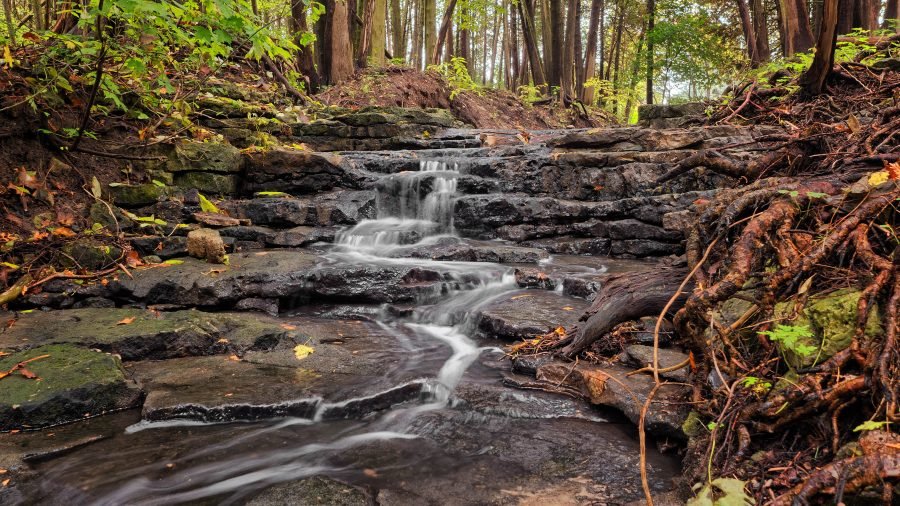
Trails
Confederation Park
Located on the East end of Fergus, Confederation Park is a place for everything; picnics, fishing, walking or biking, and great photo opportunities are here.
Riverside / Templin Gardens
Take a stroll riverside behind the Downtown Fergus shops. Our new riverside trail connects to Templin Gardens. Sit, relax, and enjoy the sounds of the waters rushing by.
Aboyne Trail
Arguably the best wooded trail in Fergus, the Aboyne Trail is an easy walk with spectacular views. Get lost in the mix of poplars and maples or sit riverside and watch fisherman cast off.
Grand River Arboretum Trail
Down the hill from the Grand River Arboretum you will find a beautiful open trail overlooking the gorge of Fergus. Further down the trail meets with the Grand River… the perfect spot to walk your dog and let him or her swim in the shallow waters.
Museum Trail
In the heart of Centre Wellington lies the Wellington County Museum and Archives. Make your way here, park, and explore around the grounds of the museum. The Aboyne Trail entrance is across from the Museum as well. Visit the museum, then head down and get lost in the woods.
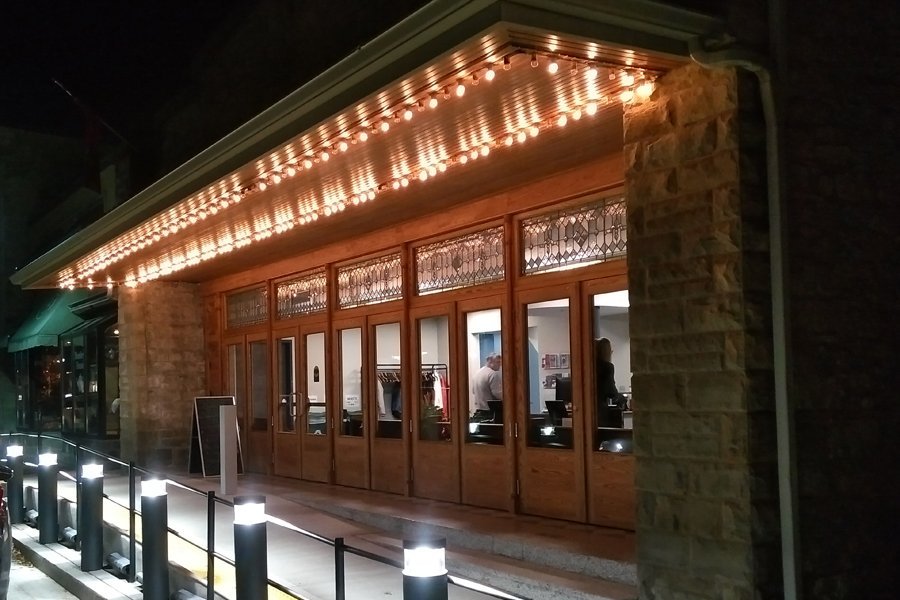
Grand Theatre
Fergus Grand Theatre
A part of the community since 1928, the Fergus Grand Theatre is rented out year-round to many different individuals and organizations who use the building to stage a wide variety of artistic, cultural, corporate, and charitable events.
The Fergus Grand Theatre was the dream of Sam Fardella, who turned the site of an old barn into a theatre on the main street of Fergus. On August 28, 1928, Louis B. Mayer, the head of MGM in Hollywood, sent Sam best wishes by telegram on the Grand Theatre’s opening night.
Throughout the 1930’s, 40’s and 50’s the Grand Theatre presented not only movies but also plays, concerts and other live events. With the rise of drive-ins and television in the late 50’s and early 60’s the theatre’s popularity started to dwindle.
Cable television pioneer Jake Milligan bought the building in the late 1960’s to house the rapidly growing Fergus-Elora Cable TV, as well as an electronics store. Live performances returned in the early 1980’s with shows produced by the Elora Community Theatre and other local and regional theatre companies.
Hugh and Lorraine Drew-Brook bought the building in the early 1990’s and a professional summer theatre started in 1993. Theatre on the Grand came to an end in the summer of 2003 and the building then became the property of the Township of Centre Wellington.
Today the Fergus Grand Theatre has one full-time staff member and a small army of volunteers. It is rented out year-round to a large and growing list of individuals and organizations that use it for a wide variety of artistic, cultural and corporate events. Together these people are making the Fergus Grand Theatre a “community meeting place” once again.
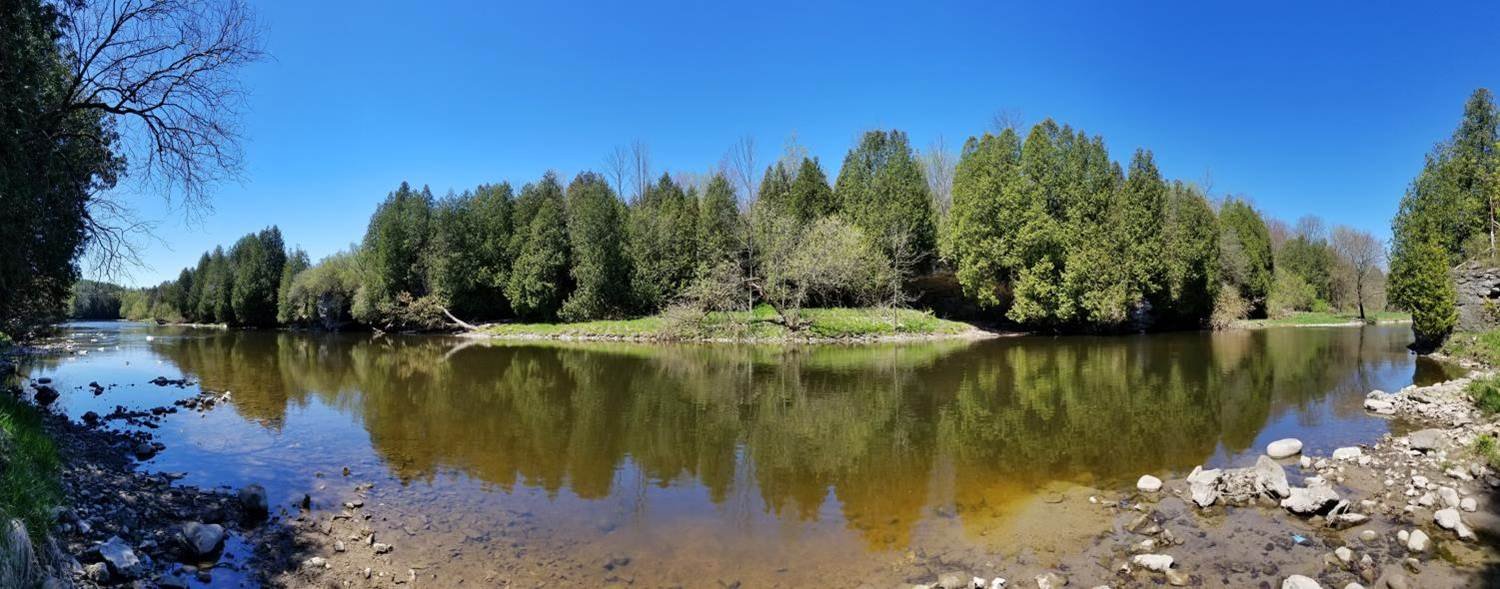
Fishing on the Grand River
Gow Park / Craighead Cottage
Locals know to go here. Just down the hill behind Craighead Cottage, one of Fergus’ earliest homes, you’ll find a perfect spot to throw the line. A small cave opposite the river (which leads to fishing spot #4) helps calm the waters and promotes a great spawning ground. If you’re looking to catch (and release!) a big brown trout, show up here.
Pierpoint Park
A fly fisherman’s dream. Shallow waters, wide river, and a long stretch will bring a grin to your face. But be sure to get there first as this is a popular spot. There always seems to be someone with an ‘I almost had it!’ story.
Blair Park / Grand River Arboretum Trail
Opposite Gow Park and Craighead cottage you’ll find Blair Park and the Grand River Arboretum. Multiple trails lead down to the river for a chance to catch the fish as they travel.
Confederation Park
Located on the East side of Fergus, Confederation Park has some of the best views in Fergus. This place is perfect for both the professionals and the entire family. Whether your looking for the monster brown trout or just looking for a picnic and fish experience, this is it.
Templin Gardens
Right here in Downtown Fergus is some of the best fishing you’re going to experience. Stroll down the stone steps of Templin Gardens and cast off.


